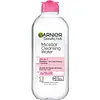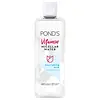What's inside
What's inside
 Key Ingredients
Key Ingredients

No key ingredients
 Benefits
Benefits

 Concerns
Concerns

No concerns
 Ingredients Side-by-side
Ingredients Side-by-side

Water
Skin ConditioningCyclopentasiloxane
EmollientPPG-26-Buteth-26
Skin ConditioningPEG-40
HumectantHydrogenated Castor Oil
EmollientPropylene Glycol
HumectantGlycerin
HumectantParaffinum Liquidum
EmollientSodium Benzoate
MaskingDisodium EDTA
Parfum
MaskingHydrolyzed Milk Protein
Skin ConditioningCitric Acid
BufferingAloe Barbadensis Leaf Juice
Skin ConditioningMaltodextrin
AbsorbentDipotassium Glycyrrhizate
HumectantNiacinamide
SmoothingRetinyl Propionate
Skin ConditioningTocopheryl Acetate
AntioxidantSodium Ascorbyl Phosphate
AntioxidantCamellia Japonica Seed Oil
EmollientOxalis Triangularis Oil
Skin ConditioningVaccinium Myrtillus Fruit Extract
Skin ConditioningEremanthus Erythropappus Branch/Leaf Oil
Skin ConditioningSaccharum Officinarum Extract
MoisturisingCitrus Aurantium Dulcis Fruit Extract
MaskingCitrus Medica Limonum Fruit Extract
Skin ConditioningAcer Saccharum Extract
Skin ConditioningMethylparaben
PreservativeEthylparaben
PreservativePhenoxyethanol
PreservativePanthenol
Skin ConditioningGlycine
BufferingSodium Lactate
BufferingPotassium Sorbate
PreservativeSodium Citrate
BufferingWater, Cyclopentasiloxane, PPG-26-Buteth-26, PEG-40, Hydrogenated Castor Oil, Propylene Glycol, Glycerin, Paraffinum Liquidum, Sodium Benzoate, Disodium EDTA, Parfum, Hydrolyzed Milk Protein, Citric Acid, Aloe Barbadensis Leaf Juice, Maltodextrin, Dipotassium Glycyrrhizate, Niacinamide, Retinyl Propionate, Tocopheryl Acetate, Sodium Ascorbyl Phosphate, Camellia Japonica Seed Oil, Oxalis Triangularis Oil, Vaccinium Myrtillus Fruit Extract, Eremanthus Erythropappus Branch/Leaf Oil, Saccharum Officinarum Extract, Citrus Aurantium Dulcis Fruit Extract, Citrus Medica Limonum Fruit Extract, Acer Saccharum Extract, Methylparaben, Ethylparaben, Phenoxyethanol, Panthenol, Glycine, Sodium Lactate, Potassium Sorbate, Sodium Citrate
 Reviews
Reviews

Ingredients Explained
These ingredients are found in both products.
Ingredients higher up in an ingredient list are typically present in a larger amount.
Disodium EDTA plays a role in making products more stable by aiding other preservatives.
It is a chelating agent, meaning it neutralizes metal ions that may be found in a product.
Disodium EDTA is a salt of edetic acid and is found to be safe in cosmetic ingredients.
Learn more about Disodium EDTAGlycerin is already naturally found in your skin. It helps moisturize and protect your skin.
A study from 2016 found glycerin to be more effective as a humectant than AHAs and hyaluronic acid.
As a humectant, it helps the skin stay hydrated by pulling moisture to your skin. The low molecular weight of glycerin allows it to pull moisture into the deeper layers of your skin.
Hydrated skin improves your skin barrier; Your skin barrier helps protect against irritants and bacteria.
Glycerin has also been found to have antimicrobial and antiviral properties. Due to these properties, glycerin is often used in wound and burn treatments.
In cosmetics, glycerin is usually derived from plants such as soybean or palm. However, it can also be sourced from animals, such as tallow or animal fat.
This ingredient is organic, colorless, odorless, and non-toxic.
Glycerin is the name for this ingredient in American English. British English uses Glycerol/Glycerine.
Learn more about GlycerinWater. It's the most common cosmetic ingredient of all. You'll usually see it at the top of ingredient lists, meaning that it makes up the largest part of the product.
So why is it so popular? Water most often acts as a solvent - this means that it helps dissolve other ingredients into the formulation.
You'll also recognize water as that liquid we all need to stay alive. If you see this, drink a glass of water. Stay hydrated!
Learn more about Water